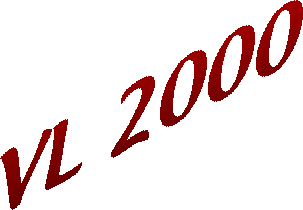
Seattle, Washington
September 10-14, 2000

|
IEEE Symposium on Visual Languages
Seattle, Washington September 10-14, 2000 |

| Tutorial T3 - | Advanced Visual Modelling: Beyond UML |
| Joseph Gil (Technion IIT, Israel) | |
| John Howse (University of Brighton, UK) | |
| Stuart Kent (University of Kent, UK) |
Wednesday, September 13, 3:30 PM
With the adoption of UML by the OMG and industry as the linguae-francae of visual systems modelling, one begins to ponder what will come next in this field? This tutorial brings a vision for visual modelling beyond UML. We present and consolidate radical new notations, proposed in a series of research papers and with quickly increasing adoption by industry, for the specification of complex systems in an intuitive visual, yet precise manner. The recurring theme of these notations is the upgrading of familiar diagrams into a powerful visual language. Spider diagrams considerably extend Venn-diagrams to the specification of OO-systems. Most familiar OO-concepts are translated to set theoretical terms: class into set of objects, inheritance corresponding to subset, and even Harel's statecharts interpreted as the set of objects in that state. Constraint diagrams enhance the arrow notation to describe static system invariants which cannot be described by UML class-object diagram. Reasoning rules are developed for the notation and strong completeness results are given. Finally, 3D-diagrams show how the third dimension and VRML modelling can be used for a conceptual modelling of dynamic system behaviour. Much of the tutorial will be based on a case study developed in industry, illustrating how the new notations are combined with those of UML, including OCL.
Highlights include:
The tutorial is primarily targeted at technology seekers, with an interest in visual modelling and reasoning, its future developments and trends. Another primary audience is modellers in industry and elsewhere who are struggling with UML and current visual modelling tools, and would be interested to experience a richer and more integrated approach. The notation presented can be used by anyone, anywhere, using paper and pencil or even a palm pilot organiser, to convey complicated logical formulae in an intuitive, yet unambiguous form. This notation can easily be taught to non-professionals, and used as a language of correspondence of technical matters in an easy format. Finally, researchers and students will find in this tutorial some exciting directions for future research.
Some sight of UML, or similar notations, would be beneficial, though not essential. Most aspects of the notation can be understood by anyone with basic mathematical education and an elementary understanding of sets, relations and logic.
Earlier versions of this tutorial were presented at conferences such as ECOOP 1999 and TOOLS USA 1999 with wide attendance and good reviews and in numerous industrial and academic tutorials in the UK and Israel. Versions of this tutorial were presented earlier this summer at ECOOP 2000 and ICSE 2000 and TOOLS Europe with good reviews. The main body of the tutorial is based on a series of recent research papers (e.g., Kent 1997, Gil & Kent 1998ab, Gil et al. 1999ab, Howse et al 1999, Kent & Gil 1998, Kent & Howse 1999, Lauder & Kent 1998, Kent et al. 1998). Some of the material is based on recent presentations of research, including papers at OOPSLA'97, ICSE'98, ECOOP'98, VL'99, UML'99. It is also based on experience of modelling work with UML in industry (chiefly with Nortel and BT), preparing and delivering training courses on UML for industry and tutorials on UML at ETAPS and OOPSLA, collaborative research work on the semantics of UML (Hamie et al. 1998abc, Kent et al. 1997) and on the presenters' academic teaching.
Note - the tutorial is a joint effort between the three presenters. However, in order to avoid a disjointed presentation, it is our practice that the contact person will make the presentation, with only occasional help (such as in the demonstration of tools, or in specific case studies).
Dr Joseph (Yossi) Gil: Assistant Professor at Technion Israel and served as the head of the software and systems development laboratory there. Widely published in many journals and conferences on a broad spectrum of topics, including the theory and practice of Computer Science. Recently spent a year with IBM Research, New York. Chair of TOOLS USA'98 and on the programme committees for numerous conferences including past & present OOPSLAs and ECOOPs. An experienced university teacher and trainer to industry.
Dr John Howse, mathematician, computer-scientist, consultant and trainer to industry and Principal Lecturer at the University of Brighton, focuses his research on semantics for OO and visual languages, and in diagrammatic reasoning. He brings years of excellence in teaching in academic and industrial environments.
Dr Stuart Kent: Senior Lecturer in Computing at University of Kent, UK, and consultant and trainer to industry on both sides of the Atlantic is the originator of constraint diagrams. Research active in the areas of visual modelling, OOD and CBD. He conducts active research on OO modelling and design, delivered tutorials, published and has been member of program committees of conferences such as TOOLS, UML, VL, and EDOC. He is Conference Chair of UML2000.